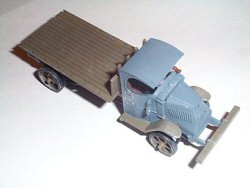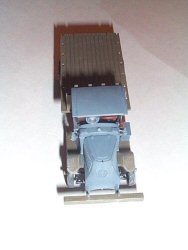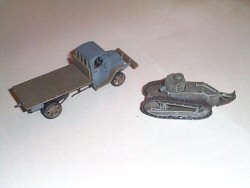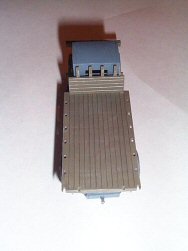
RPM 1/72 Mack AC 'Bulldog' Type EHT Build Review
By Bill Kreuger
| Date of Review | July 2005 | Manufacturer | RPM |
|---|---|---|---|
| Subject | Mack AC 'Bulldog' Type EHT | Scale | 1/72 |
| Kit Number | 72403 | Primary Media | Styrene |
| Pros | Nice detailing | Cons | |
| Skill Level | Basic | MSRP (USD) | $9.98 |
Background
The heavy-duty Mack AC truck was a hard-tired, chain driven all purpose truck that was used by British, French and American troops during World War 1. The first AC model was introduced in 1916. There are a couple of stories surrounding the trucks’ “Bulldog” moniker. One says that British soldiers in France said the Mack truck had the tenacity of a bulldog. At that time, the bulldog was one of the symbols of Great Britain. Another says that whenever other trucks could not make it, British troops would yell, “Bring the Bulldogs in!” It may also be the snub-nosed appearance of the truck that gave it the well-known nickname. By 1922, Mack trucks had adopted the Bulldog as its symbol, using it in advertising and on truck name plates.
The Kit
This kit is one of four offerings by RPM in 1/72 scale of an early model Mack truck. Like the other versions, it comes in an end-opening box with color drawings of the completed truck on one side. The front/top of the box shows the truck in use, presumably by French troops, in the process of moving a Char Schnieder tank onto the bed. Inside are two large sprues of light gray plastic contained in one cello bag, along with a sheet of decals. The sprues are marked “A” and “B”, and coincide with the drawings provided in the instruction sheet. The instructions consist of 8 pages which break down the construction into 36 steps. Each step is illustrated as a drawing showing the number and placement of parts. The front page has an illustrated view of placement of decals and black and white drawings of the back of the box color drawings. There are approximately 120 parts to this kit, with many parts unused that will make nice additions to the spares box.
Construction
Since a similar kit has already been reviewed, I will not give a step by step description of the construction of this kit. I would prefer to give overall good points and bad points.
Good points:
- For a 1/72 scale kit, it is very detailed. Details include a complete engine, exhaust system and transmission linkage. It is too bad that most of the engine is hidden by the hood.
- The kit, for the most part, was easy to build. You need to pay close attention to the instructions while building the kit.
- The kit was well engineered, in regards to the fit of parts. All parts fit very well together.
- There was no flash on the parts that I used, although some was present on other parts. There was very little clean-up needed on most parts, except for the scraping or sanding away of mold seams.
- There are paint color numbers and samples of colors provided on the back of the box. It would have been nice if these colors were described a little more. I ended up using a medium blue for the chassis and cab, along with olive drab for the bed and front fenders.
For the most part, I had fun building this kit.
Bad points:
- The parts are quite small, you have to expect that for a 1/72 scale kit. It was somewhat hard on the eyes trying to see where parts fit.
- The instructions, although easy to follow, have a lot to be desired in regards to accurately showing where parts fit. The drawings are often out of scale, or do not clearly show where the parts are to fit onto the model. I had an especially hard time with the transmission assembly to the chassis frame and the assembly of the chain drive sections (steps 16-20). Additionally, I am not sure if I had the cab in the correct location, as the driveshaft was about 1/8” short of where it fits into the transmission. I had to do a little creative assembly to get it to fit correctly. Finally, the assembly of the steering column and linkage (Step 27) was very fiddly. The lack of space made it hard to work on.
- Parts sprues are not numbered, except for indicating which is A or B. You have to constantly refer back to the layout in the instructions to correctly locate parts for each assembly. The same is true with the decals.
- There are a myriad of decals provided in the kit, but nowhere in the instructions does it show exactly what units or groups used these markings. The only instructions for markings are on the front page of the instructions, and show basic factory markings and markings for an Engineering Department vehicle.
Conclusions
I would recommend this kit to anyone, especially those with an interest in World War 1 vehicles, or early 20 th century American trucks and vehicles. Although the kit is fairly straight forward, it may be a bit difficult for a novice. Some experience may be needed for some of the assembly.
Despite these “bad points” the kit builds up into a very nice model of a unique military vehicle. Most of the assembly is straight forward. There were a few spots where I felt a little like tearing my hair out, indicated above. However, make sure you study the instructions closely and dry fit the pieces before final assembly.
My sincere thanks to Squadron Mail Order for this review sample!













